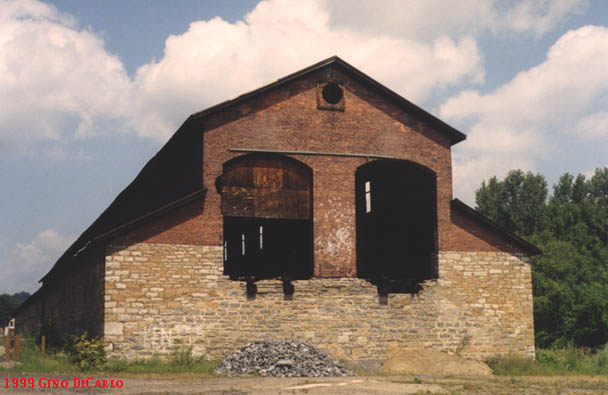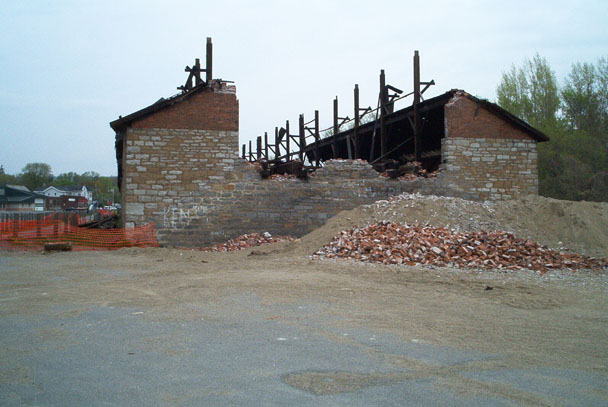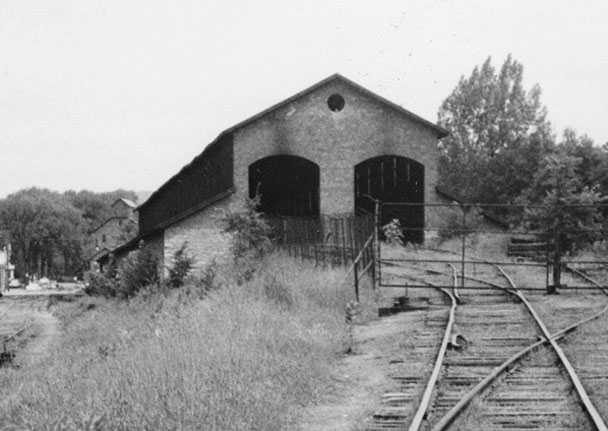|
|
|
|
with Gino DiCarlo
In 1900, it was a monument to technology in the service of commerce-a mammoth coal house 60 feet wide and 336 feet long with a capacity of 10,000 tons of coal.
The new coalhouse was erected in the Gloversville Yard of the Fonda, Johnstown, and Gloversville Railroad with stone quarried in nearby Palatine, lumber from the Willard sawmill in Northville, and 12 inch square yellow pine trestle timbers from Macon, Georgia. As the Gloversville Daily Leader noted, "It will have a cement floor, something that is not possessed by any of the existing coal houses".
Perhaps most marvelously, the Daily Leader reported that the banks of the west branch of the Cayadutta creek would be walled and its waters covered by the building's cement floor, so that "as far as all practical purposes are concerned the stream is not considered as having an existence."
|
The FJ&G Coal House in 1960. The now-demolished engine house and multi-story freight house are visible to the rear. courtesy of Gino DiCarlo
|
|
|
Although FJ&G freight cars carried hides, finished leather goods, and lumber milled from the timber rafts that floated down the Sacandaga River each spring, the railroad's biggest business was hauling coal. Although mills and other large customers received carloads of coal on sidings that crisscrossed the city streets, the coal house was intended to service smaller customers, whose deliveries would be loaded into wagons on the level beneath the trestle. The Daily Leader predicted that the new coalhouse "will make the price of coal so moderate that the present business of hauling coal from Fonda and Fultonville by wagon will be made so unprofitable that it may be abandoned".
Nor was speculation in real estate was not a stretch for the FJ&G. Founded in the 1870s, the railroad touched every corner of the local economy from its Gloversville headquarters. It operated the street car system that linked the mill towns of Gloversville, Johnstown, Fonda, and Amsterdam, a spur line to the resort at Mountain Lake, and a short line freight and passenger railroad that branched north on either side of the Sacandaga River to railheads in Broadalbin and Northville. Near the end of the Northville line, the railroad built the bungalow community of Sacandaga Park, and operated an amusement park and a large hotel called "The Adirondack Inn".
|
|
|

The FJ&G Coal House in 1999
photo ByGino DiCarlo
|
Indeed, operated by an FJ&G subsidiary called the Fulton County Coal Company, the coal house did good business for a generation or two. But the glove industry buckled at the knees under less favorable tariff laws in the late 1920s and then crumpled under the weight of the Great Depression. War work kept the factories going for another half-decade, but by the late 1940s the Glove Cities were losing mills, jobs and people. At the same time, heating oil and propane were replacing coal as the residential heating fuel of choice.
The FJ&G had lost its Northville branch and amusement park to the rising waters of the Sacandaga Resevoir in 1929 and its streetcar line to the automobile by the 1940s. The truncated railroad struggled on until 1984, but the last coal car had departed in the early 1970s. Eventually the building passed into the hands of the City of Gloversville, which used it to store building supplies, road repair material, and rock salt.
Although the building still appeared fortress-like in the photographs from the late 1990s, visitors, while marveling at the intact 100 year old 12 inch beams, noted that the walls were cracking and that a large section of roof had collapsed.
|
|
|
In 2002, the venerable building had its last chance at resurrection. After the City of Gloversville was offered a $100,000 state grant to build a salt storage facility, a city councilman suggested renovating the Coal House for this purpose. There was some local support for preserving what, after the destruction of the FJ&G freighthouse by teenage arsonists in 2001, was the last large railroad building in the city.
However, the councilman's idea came to naught, and in early 2003 the Coal House was demolished at age 103. Its replacement is a pre-fabricated metal tepee shielding a pile of rocksalt.
Although its main branches had less than 100 miles of track, the FJ&G is one of the best documented shortline railroads on the Internet. The key sources of information are Gino DiCarlo's Railpage and the 65 member Yahoo FJ&G group moderated by Gino.
The FJ&G group has a particularly extensive section of pictures contributed by its members, several of whom are former railroad employees. Paul Larner's post of the March 3, 1900 Daily Leader article was a key source regarding the construction of the coal house.
In addition to playing a major role in the construction of the FJ&G Railpark in downtown Gloversville, Randy Decker has authored a photographic collection, The Fonda, Johnstown, & Gloversville Railroad, (Charleston, SC: Arcadia Publishing) 1998.
As an aid to scale modellers, Model Railroader published the blueprints of the FJ&G coalhouse in its March,1979 issue.
|

The FJ&G Coal House in April 2003
Photo ByGino DiCarlo
Click here to see additional pictures of the "Last Days" of the Coalhouse.
Click here to see "The Atlantis of the Adirondacks", our page on the FJ&G Sacandaga Park amusement midway.
|
|
|
|
|


